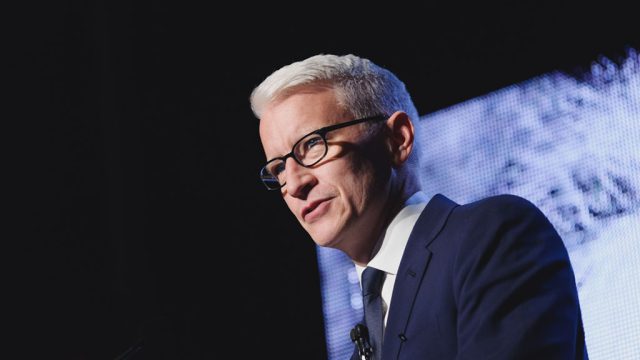Anderson Cooper on the Photograph That Changed His Life

Long before he became a thorn in President Trump’s side, Anderson Cooper, the erudite host of CNN’s Anderson Cooper 360, spent much of the last two decades doggedly following a trail of bloodshed and chaos to all corners of the world: Somalia, Bosnia, Rwanda, Afghanistan, Iraq—and don’t forget the shootings and natural disasters that plague our country on a seemingly weekly basis. He’s been shot at. He’s been jailed. He’s seen children die. Throughout it all, he hasn’t stuttered a bit.
Cooper has recounted these tales in two books, Dispatches from the Edge and The Rainbow Comes and Goes, the latter of which he co-wrote with his mother, Gloria Vanderbilt. (Yes, those Vanderbilts.) Not every man would be able to handle such devastating experiences so deftly and candidly, let alone return over and over and over again. So how does he do it? Well, it boils down to a single moment:
“I keep a photo tacked to the cork board in my office at CNN. It’s from Rwanda during the genocide. A friend of mine who was a photographer took it. It’s a picture of me taking a picture of a massacre scene, five people who had been killed. Their bodies had begun to decompose, and I was photographing the skin on this person’s hand, which had peeled off like a glove.
“My friend showed me the photo and said, ‘Do you see yourself?’ For me it’s a moment when I realized I had crossed a line and was not really seeing things properly anymore. I was photographing this with my own camera, and not for the story I was covering.
“You know, you get to a place where you can see certain things and function. It was harder early on in my career, because it’s all shocking, and it’s still shocking, and it should be shocking. But you have to figure out a way to get past that. Everyone always asks the question ‘Why does something like this happen?’ You get to a place where you don’t have to ask that question, ‘Why?’ You can live in a world where there isn’t any why. It just is.
“That’s when atrocity runs the risk of becoming similar. You have to really fight that. There’s a tendency to compare one event to the other and have this sort of sliding scale of sorrow. You run across people who swagger around and say, ‘Oh, this isn’t as bad as it was in Rwanda in ’94!’ I’ve been around people like that, and it always strikes me as kind of inappropriate to compare tragedies. Each place is unique. Every story is different. When you get to a point where you think of all the stories as the same, then you need to stop doing it. You stop reacting in a way you should react as a human being.
“I keep that picture as a reminder.”
For more amazing advice for living smarter, looking better, and feeling younger, follow us on Facebook now!